Nevada movement draws the line on human trafficking

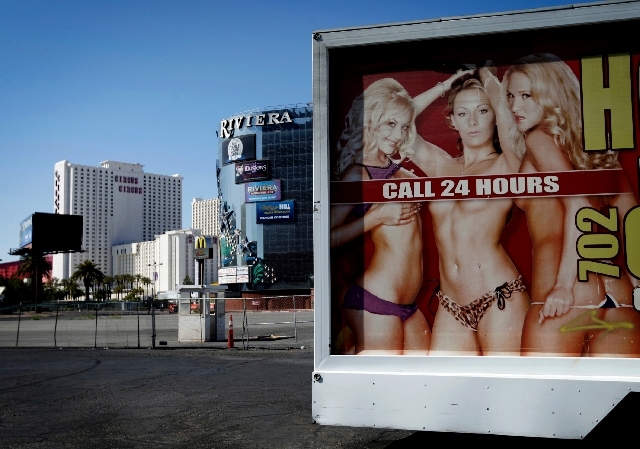
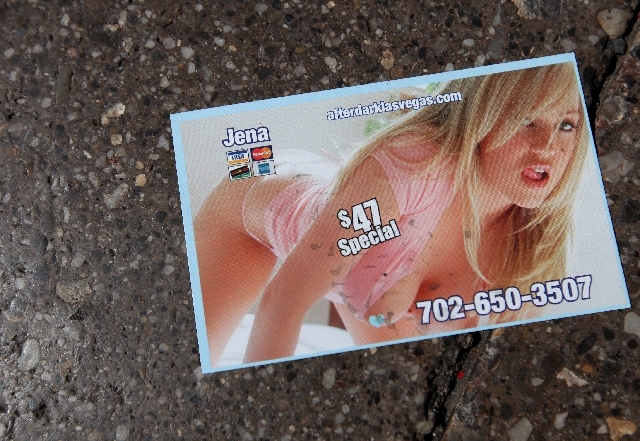
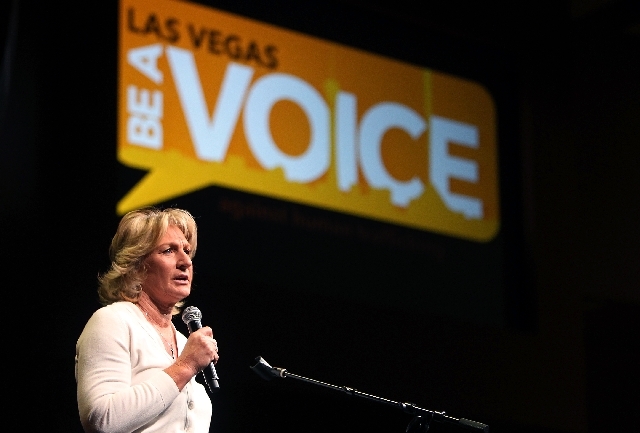
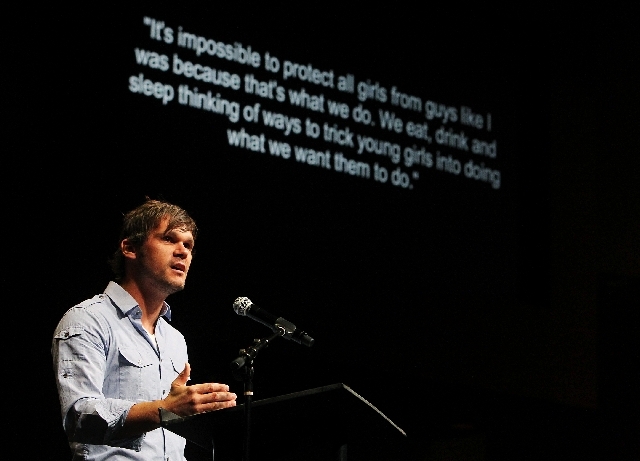
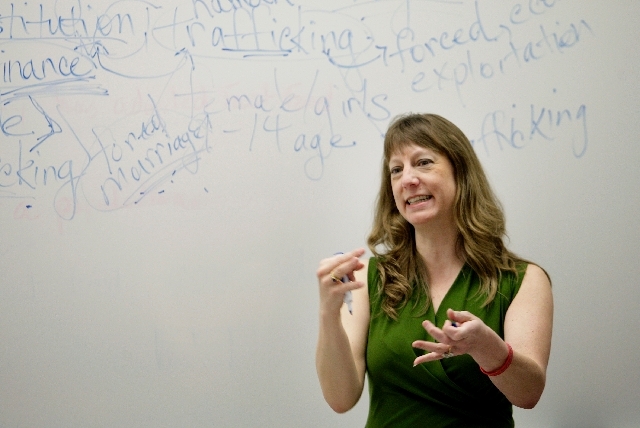
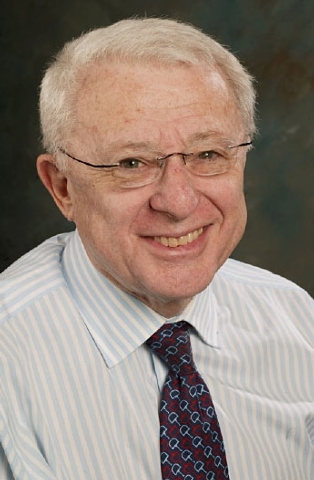
There was a time when the term “human trafficking” stirred images of Third World immigrants working their fingers to the bone in sweat shops, sewing the latest fashions at a warehouse in the garment district of some major American city.
They worked in cramped, deplorable conditions, for hours on end, for little or no pay, and were kept beyond their will.
Over the past decade or so, however, the definition of human trafficking has been evolving to include the women working the bars, strip joints, dance clubs, outcall or escort services, massage parlors and street corners in search of tricks or johns.
And now a modern-day abolitionist movement that includes Las Vegas law enforcement officials, the state attorney general’s office, legislators and grass-roots activists — supported in many cases from local pulpits — wants to reclassify the pimps who dominate the world’s oldest profession as modern-day slave traders.
Their efforts have resulted in Assembly Bill 67, now pending in Carson City. The proposed law would make pimps liable for longer sentences if they force or coerce anyone into prostitution. If the prostitute is younger than 14, the pimp could be sentenced to life in prison.
“The heat is on the pimps; they’re just users and abusers,” said Alexis Kennedy, a University of Nevada, Las Vegas criminal justice professor and member of a local human trafficking task force. “And it’s important to address them first and foremost. When you reduce the supply, you reduce the business. The places that have been most successful are the ones who go after the customers and the pimps, not the prostitutes.”
The legislation, which has been heavily amended since its introduction, does some of that. It generally casts prostitutes — especially minors — as victims in need of social services, and adult prostitutes would still face only misdemeanor solicitation charges. Their customers’ punishment wouldn’t change.
The bill has encountered opposition from sex workers, who say it discounts their ability to willingly work in the sex industry, and from the American Civil Liberties Union.
“The law, as it’s written, makes the assumption that nobody would possibly ever get into the line of work unless they were brainwashed or forced into it, or they were simply out of control and could not control their bodies,” said Allen Lichtenstein, the ACLU’s legal counsel. “Sex trafficking and involuntary servitude are serious problems. On this we can all agree, but there needs to be some safeguards to create a balance so if some woman gets mad, she can’t just later on say, ‘Oh, I’ve been trafficked. He made me do it.’ ”
Other critics say the legislation, and the movement behind it, blur the difference between human trafficking and simple prostitution.
Michael Horowitz, the conservative think tank fellow considered the father of the federal Trafficking Victims Protection Act of 2000, has even harsher words for what has become of his progeny.
The anti-trafficking movement has changed, he says: “Now it’s just one big federal entitlement program, and everybody is more worried about where they’re going to get their next grant and whether they are going to get it.”
OUT OF SIGHT, OUT OF MIND
Nevada Attorney General Catherine Cortez Masto, who has lobbied hard for AB67, said Nevada has a significant problem with sex trafficking.
“The youngest child sex-trafficked in Las Vegas was 13 years old and the youngest in Reno was 12 years old,’’ she told the Review-Journal. “AB67 establishes the crime of sex trafficking in Nevada, provides harsh penalties against the convicted perpetrator, and focuses on the protection of our victims — to restore them and restore their dignity by building the infrastructure to support their recovery.”
Few would argue that prostitution is a pretty business. And most would agree that no state is as conflicted about it as Nevada.
Silver State residents, political and business leaders are properly outraged by child prostitutes, hookers hassling tourists and locals on the Strip and elsewhere, and abusive, outrageous pimps. They are much less so when it comes to legal brothels in rural counties, women quietly working casino bars and clubs, prostitutes dispatched to hotel rooms, or those working in massage parlors.
For the most part, if it is out of sight, it is out of mind.
Against that backdrop, the Metropolitan Police Department last year painted a grim picture of Las Vegas in a pitch for a federal grant to combat human trafficking:
“Trafficking of minor girls to Las Vegas from other states for the purposes of prostitution, has and continues to be a highly desired destination for pimps,” the grant application reads. “Las Vegas has become a prime target state for sex trafficking due to the highly sexualized Las Vegas landscape catering to tourists hoping to partake in some of ‘Sin City’s’ lifestyle.”
The grant singled out the city’s 30 Gentleman’s Clubs, “where pimps/traffickers lure young women from across the country and around the world to be groomed as ‘Exotic dancers.’ These pimps look to ‘Turn them out’ into a life of prostitution after exposing them to ways to sexualize their interaction with men through exotic dance.”
After describing the “robust advertising campaign for adult entertainment, escort services and massage establishments,’’ the grant writer states, “these images dot the landscape in a city where sex trafficking is widespread. …”
But is Sin City the center of human trafficking and a growing global flesh trade? Even the grant application indicates that much of the underage prostitution is homegrown.
The Metropolitan Police Department’s vice unit reported that 2,144 sex-trafficking victims under age 18 have been “rescued” in Las Vegas since 1994, an average of 126 per year, according to the application. More than half (1,080) were from Nevada; 542 were from California and the rest came from other states.
In 2011, the only year broken out individually, the unit reported 131 minors were “recovered,” and 74 percent of them were from Southern Nevada.
The report offered little about the people behind the numbers. No information was presented on their ages, circumstances of their arrests, or whether the total reflects multiple arrests of the same person.
While not specifically talking about child prostitutes, police spokesman Bill Cassell said the multiple-arrest factor is a common problem in compiling statistics.
The grant application touches briefly on adult prostitution, noting that “in 2011 alone, the PIT (Pandering Investigation Team) handled 95 adult sex-trafficking cases, many involving multiple victims of brutal pimps. Of these, 34 arrests were made with a 30 percent conviction rate.”
But a police spokesman said the department does not keep statistics on the total number of prostitution arrests each year.
“It’s hard to put a number on it,” said Lawrence Hadfield, speaking on behalf of Lt. Karen Hughes, the vice unit commander.
He said prostitution arrests aren’t tracked the same way as crimes such as armed robbery or assault. They’re recorded as “detaining a person,” a broad category for many minor offenses cited hundreds, if not thousands, of times each month.
While those arrests seldom get much notice, the city’s sex trade was laid bare by a Feb. 21 altercation between two self-proclaimed pimps that killed three people.
Ammar Harris, 27, who authorities allege ran a high-end prostitution ring that moved women between Miami and Las Vegas, is accused of shooting and killing another reputed pimp, Kenneth Cherry Jr., as the two were driving on the Strip. Cherry’s sports car crashed into a taxi, killing the driver and his passenger, a woman from the Seattle area.
Harris faces multiple felony charges, and prosecutors are seeking the death penalty.
Two months later, Arman Izadi, 28, was arrested in a raid of his Strip luxury high-rise apartment after a woman told police he was her pimp, and that he had subjected her to beatings, waterboarding, forced tattooing and death threats — dangling her off the apartment balcony among them — when she told him she wanted to quit selling herself. He faces 15 felony charges.
The woman, a law student, told police she met Izadi at a Las Vegas nightclub and willingly went to work for him, but had tired of the trade.
Those high-profile incidents aside, it’s impossible to quantify the sex-for-pay industry in Las Vegas.
Hadfield said asking how many pimps and prostitutes work the city “is like saying, ‘How many drug dealers are there in the city?’ ”
HUMAN TRAFFICKING COMPLICATED
Hughes declined multiple requests for interviews for this story. She also denied requests for a copy of the federal grant application, which the Review-Journal obtained from the U.S. Department of Justice through the federal Freedom of Information Act.
In a brief conversation last fall, she said human trafficking is a complicated subject, and compared it to global warming.
“You need to do research on the Internet for its definitions,” she said.
And while she often appears in churches and at other public gatherings to recount horrific stories of abuse by pimps, Hughes offers few details.
Asked about instances where people have been trafficked into or out of Las Vegas, their bodies exploited and sold for sex, she said there are traffickers who shuttle children through Las Vegas on their way to the Pacific Northwest.
“There are different circuits that the pimps run,” she said. “And the Pacific Northwest is one of them.”
The Metropolitan Police Department’s grant application was convincing: The Justice Department awarded Las Vegas police nearly $500,000 over two years to combat human trafficking. Most of the money will cover overtime pay for vice officers, and $143,000 for the two-year salary of Lou Pascoe, a former Las Vegas police officer who is director of the newly formed Southern Nevada Human Trafficking Task Force. It is the second such grant the department has received.
The Salvation Army’s Seeds of Hope program, administered by Stacey Cramer, also received a $500,000 grant to provide services to victims of sex trafficking and labor trafficking.
At public forums, Cramer points out that sex trafficking is only part of the picture, and that labor exploitation does exist.
Yet, little labor exploitation has been found in Las Vegas.
“Information received from the U.S. Attorney General’s Office show there were two incidents considered to be foreign labor trafficking cases between 2009 and 2010 with 10 total victims,” the police department’s grant application reads. “These cases were prosecuted using statutes outside of human-trafficking laws but resulted in the successful prosecution of eight traffickers. Victims in both these cases were served by the Salvation Army.”
Conversely, in 2008, a total of 69 sex-trafficking victims were identified, of which 68 were female and 62 were minors.
“We have seen a lot of younger girls who’ve gotten involved in gangs,” Cramer said, adding that 75 of the victims her program helped last year were in that category, and 65 were children.
Cramer’s program itself represents the shift to considering prostitutes as victims, not willing criminals.
“It’s psychological abuse,” she said of the methods used by pimps. “It’s similar to domestic violence. Sometimes it’s just a perceived threat, and we are now paying close attention to it. Before we couldn’t, because there wasn’t money for them. The money was only set aside for foreign victims.
“The (Department of Justice) is realizing how many young children are being forced into prostitution, and now we’re able to serve our own children.”
PROSTITUTES COMPARED TO SLAVES
In addition to the money, the federal grant provisions require local law enforcement officials to work with their state’s attorney general to press for stronger laws against sex trafficking, and to help build community support for their passage.
Las Vegas vice cops have found receptive audiences in some local churches.
In March, Pastor Drew Moore worked the crowd at Canyon Ridge Christian Church in North Las Vegas, where Hughes has long been a member.
“What would it look like,” Moore challenged about a hundred people in the audience, “if the church went to battle in the name of Jesus? What would it look like if the church cared more about the children than the pimps? What would it look like? I ask you in the name of Jesus.”
So moved were some in the pews that they rose to their feet, their arms reaching for the ceiling, their palms open. Swaying ensued, followed by a few soft “Amens.”
Hughes, task force director Pascoe and Michon Martin, then a chief deputy attorney general, all bowed their heads in prayer. Moments earlier, all three had admonished parents to stay alert, lest their children fall prey to human traffickers.
Pascoe cited the Bible, comparing prostitutes to slaves: “The Egyptians enslaved the Israelites, making them build cities against their will, killing them if they did not.”
Martin called sex trafficking “a sad marriage between domestic abuse and child abuse.”
Hughes ticked off a list of clues that the children might already be turning tricks: “A form of branding” with tattooed names of pimps; unexplained access to fancy cars and erotic clothing; use of slang associated with prostitution such as “wifey,” “daddy,” “family” or “bottom.”
She had unadulterated scorn for pimps.
“They’re not men,” Hughes exhorted the crowd. “They dangle wealth in front of the girls like a carrot in front of their faces.”
PENALTIES FOR PANDERERS
Nevada is just one of many states re-examining crimes related to prostitution, generally known as pandering, and ordering harsh new penalties for the panderers, commonly called pimps.
A dozen states, from Arkansas to Hawaii, have already overhauled their prostitution statutes with language modeled on a federal sex-trafficking law. Many of those state laws were written by the same man, James Dold, 29, a Las Vegas native who is legal counsel for the Polaris Project, a nonprofit anti-trafficking group based in Washington, D.C.
The Polaris Project also wrote the initial version of Assembly Bill 67. Introduced on the behalf of Cortez Masto, it broadly redefines pimps as sex traffickers, dramatically increases prison sentences and narrows their ability to avoid conviction. An accused trafficker, for example, would not be able to argue that the prostitute was a willing partner in crime or plead ignorance if the prostitute is found to be a minor.
While there’s no question that prostitutes often suffer physical and mental torture by pimps, some critics of AB67 say the debate on the bill’s merits often cedes to just one side of the story.
“It’s like when you hear about the welfare cheats, and the ones who are telling the awful stories work within the Welfare Department,” said Barbara Brents, a UNLV sociology professor and author of a book whose premise is that legal brothels are much safer than the streets.
“You never hear about the good stories, the success stories, the stories where prostitution helped someone feed her family; and it never dawns on anybody to invest in more social services and help the victims instead of tougher laws to put away the pimps.”
FORMER PROSTITUTES SPEAK OUT
Warnings and horror stories about abuse of young women by their pimps and clients are regularly heard from pulpits around the Las Vegas Valley. Often they come from women who identify themselves as former prostitutes, or the relatives of prostitutes.
Andrea Swanson regularly appears to tell the story of her daughter, Hanna, who at age 18 was forced to walk the Strip and turn tricks by a much older boyfriend-turned-pimp.
The pimp was eventually convicted of attempted pandering and sent to prison for less than two years, but her daughter visited him in jail and went to live with him after his release.
“If this can attack our family, it can attack any family,” Swanson warns.
Her daughter’s boyfriend is often cited as an example of a sex trafficker, though the circumstances of Hanna’s story don’t quite fit. The man would be liable as a pimp under current law, but because Hanna was of legal age and he wasn’t accused of coercion or use of force, Assembly Bill 67’s enhanced penalties wouldn’t seem to apply.
Amy Ayoub, a close friend of Cortez Masto, has also spoken in favor of the pending legislation, and testified on its behalf in Carson City.
Ayoub, who trains people in public speaking, told lawmakers in January that she was forced into prostitution in Nevada for six years, starting when she was a teenager.
She said not much has changed in the world of prostitution since then, based on the stories she hears.
“I spoke to a group of teenage girls last year, and our stories were the same,” Ayoub said in a telephone interview. “If there’s any difference, I’d say that today there is more structured gang activity around the pimps than back then.”
She said that when she tried to run away from her pimp, he held her at knifepoint and beat her: “He knocked me down, stood on my hair and kicked me.”
Eventually she escaped.
Now in her 60s, Ayoub is on the National Commission to Eliminate Child Abuse and Neglect Fatalities and is an ambassador for St. Jude’s Ranch for Children.
Annie Lobert, who founded Hookers for Jesus, a nonprofit that helps both prostitutes and pimps, said she would be glad to speak on behalf of the attorney general or work alongside police and the task force, if asked.
The 46-year-old former Minnesota prostitute said she always thought of herself as a sex-trafficking victim, long before the term was commonly used:
“I knew I was a victim out of the bad choices I made and my circumstances, but when I woke up one day with a gun to my head, and (her pimp) said, ‘You’d better work, bitch,’ I knew that wasn’t right.”
Lobert met her former pimp at a Twin Cities strip club.
“And you don’t have to be physically forced,” she adamantly explained. “They can brainwash you to the point where you don’t know what to do next, and you end up with this certain mentality, and it’s the only thing you know in life.”
Still, as much as Lobert bashes pimps, she says not all of them are bad.
“We help some when they’re down and out and don’t have a place to turn,” she said.
LAW’S INTENT EVOLVES
The state-level movement to rebrand pandering as human trafficking has roots in the Trafficking Victims Protection Act of 2000, a federal law that has been reauthorized three times.
In the 1990s, Michael Horowitz was a fellow at the Hudson Institute, a conservative think tank in Washington, D.C., when he became interested in persecution of Christians in Africa. Working with religious groups, Horowitz won passage of the International Religious Freedom Act of 1998, which among other provisions allows the United States to sanction nations that persecute anyone based on their religion.
The Trafficking Victims Protection Act was a natural follow-up, aimed at giving the government authority to act against the international slave trade and money to finance the battle.
The original intent of the law was to withhold foreign aid from governments that either turn a blind eye to human trafficking or are complicit in it, Horowitz said from Washington, where he runs 21st Century Initiatives, an international policy think tank.
Horowitz said the anti-trafficking movement has changed into one big federal entitlement program. Congress now appropriates about $10 million per year for anti-trafficking efforts, most going to police agencies in major cities.
As the act was being written, liberal academics and feminists took pains to distinguish between sex trafficking — a form of labor exploitation — and prostitution, which many considered a right-to-work issue for those who willingly trade sex for money.
Nicole Bromfield, an assistant professor of sociology at United Arab Emirates University, has studied the trafficking law and has interviewed dozens of congressional staffers in an attempt to explain its roots.
She said few people are aware of the history behind the drafting of the act, which saw social conservatives and pro-choice liberals battling over the distinct differences between prostitution and sex trafficking.
Since then, Bromfield said, sensational, unverified stories have dominated the narrative and have replaced the reality that prostitution often can be an act of free will.
“It’s the story that’s never told,” Bromfield said. “The story isn’t as sexy as rescuing trafficking victims, especially considering the way human trafficking has been portrayed in the media in the United States.”
Bromfield’s study exposes the ideological differences that unfolded as the law was being written.
“There was a lot of squabbling,’’ one participant told Bromfield. “Was it going to be prostitution or was it going to be labor and prostitution? This is where the crack in the wall started. … Some people just wanted it to be about sex trafficking. … (But) you’ve got to have a balanced reflection of what modern-day slavery looks like.”
Some thought equating prostitution in all forms with slavery went too far.
“I despise prostitution. I don’t support it as a right-to-work issue,” another participant told Bromfield. “I think it’s inherently harmful, but I cannot, in good conscience, equate it with slavery. I can’t. It doesn’t have the same coercive quality. Not when somebody can ultimately walk away. And in slavery, by definition, you cannot.”
Yvonne Zimmerman, an assistant professor of Christian ethics at the Methodist Theological Union in Delaware, Ohio, took the analysis a step further.
“It’s important to note that not all prostitution is sex trafficking and not all sex trafficking is human trafficking,” she said.
“That’s a big distinction to make.”
Contact reporter Tom Ragan at tragan@reviewjournal.com or 702-224-5512.












